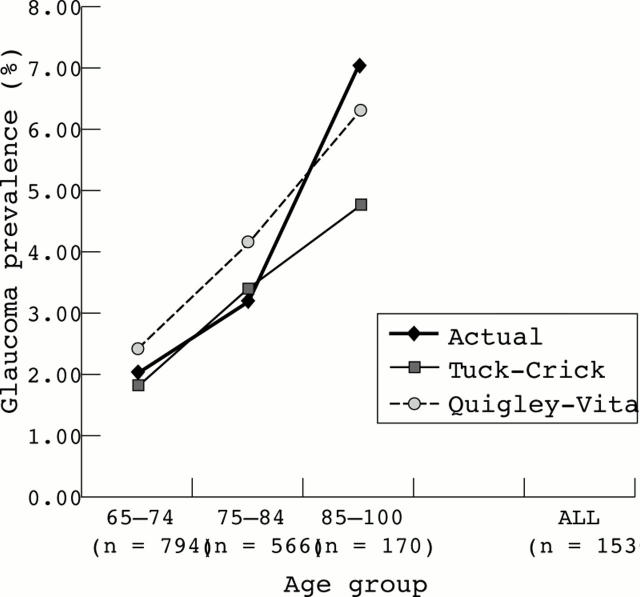Abstract
AIMS—To assess the Tuck-Crick and the Quigley-Vitale predictive regression equations against fresh independent real world data for estimating the prevalence of primary open angle glaucoma (POAG) in the UK. To apply the equations to the elderly population of England and Wales, for which there is sample survey data on glaucoma, and demographic data. METHODS—Directly measured actual prevalence of POAG in a population sample of 1530 people was compared with the predicted prevalence derived by applying the Tuck-Crick and the Quigley-Vitale equations to the sample data. The two equations were applied to the demographic data of the population to project POAG prevalence and to derive 5 year cumulative incidence for the elderly population. These were compared with estimates derived from the local survey data. RESULTS—The actual directly measured prevalence of POAG in the local sample was 3.01%. The Tuck-Crick estimate was 2.74% (difference 0.27%), and the Quigley-Vitale was 3.50% (difference −0.49%). The three methods—projection from local survey data, Tuck-Crick, and Quigley-Vitale—gave point estimates of 2.85% (228 526 cases), 2.71% (217 375 cases), and 3.50% (280 364 cases) respectively for the prevalence of POAG in the elderly population of England and Wales (8 008 705 people aged 65 or older). Calculation of incidence from age specific prevalence gave the following results: the numbers of new cases of POAG expected (5 year cumulative incidence) in the elderly population were 71 146 and 94 485 for methods 2 and 3 respectively. CONCLUSIONS—The Tuck-Crick predictive equation performed well when applied to fresh (independent) actual data from a local sample survey using a particular definition for POAG, and its usefulness for estimation of prevalence of POAG in England and Wales has been demonstrated. The work on development of predictive equations has been very promising and further refinements could be made when more fresh survey data become available.
Full Text
The Full Text of this article is available as a PDF (107.5 KB).
Figure 1 .
Prevalence of primary open angle glaucoma calculated by the Tuck-Crick and the Quigley-Vitale predictive regression equations, in comparison with the actual prevalence in a random sample of 1530 people aged 65-100, excluding African-Caribbean ethnic groups, from the North London Eye Study.
Selected References
These references are in PubMed. This may not be the complete list of references from this article.
- Jarman B. Underprivileged areas: validation and distribution of scores. Br Med J (Clin Res Ed) 1984 Dec 8;289(6458):1587–1592. doi: 10.1136/bmj.289.6458.1587. [DOI] [PMC free article] [PubMed] [Google Scholar]
- Leske M. C., Ederer F., Podgor M. Estimating incidence from age-specific prevalence in glaucoma. Am J Epidemiol. 1981 May;113(5):606–613. doi: 10.1093/oxfordjournals.aje.a113138. [DOI] [PubMed] [Google Scholar]
- Quigley H. A., Vitale S. Models of open-angle glaucoma prevalence and incidence in the United States. Invest Ophthalmol Vis Sci. 1997 Jan;38(1):83–91. [PubMed] [Google Scholar]
- Reidy A., Minassian D. C., Vafidis G., Joseph J., Farrow S., Wu J., Desai P., Connolly A. Prevalence of serious eye disease and visual impairment in a north London population: population based, cross sectional study. BMJ. 1998 May 30;316(7145):1643–1646. doi: 10.1136/bmj.316.7145.1643. [DOI] [PMC free article] [PubMed] [Google Scholar]
- Tuck M. W., Crick R. P. The age distribution of primary open angle glaucoma. Ophthalmic Epidemiol. 1998 Dec;5(4):173–183. doi: 10.1076/opep.5.4.173.4192. [DOI] [PubMed] [Google Scholar]



